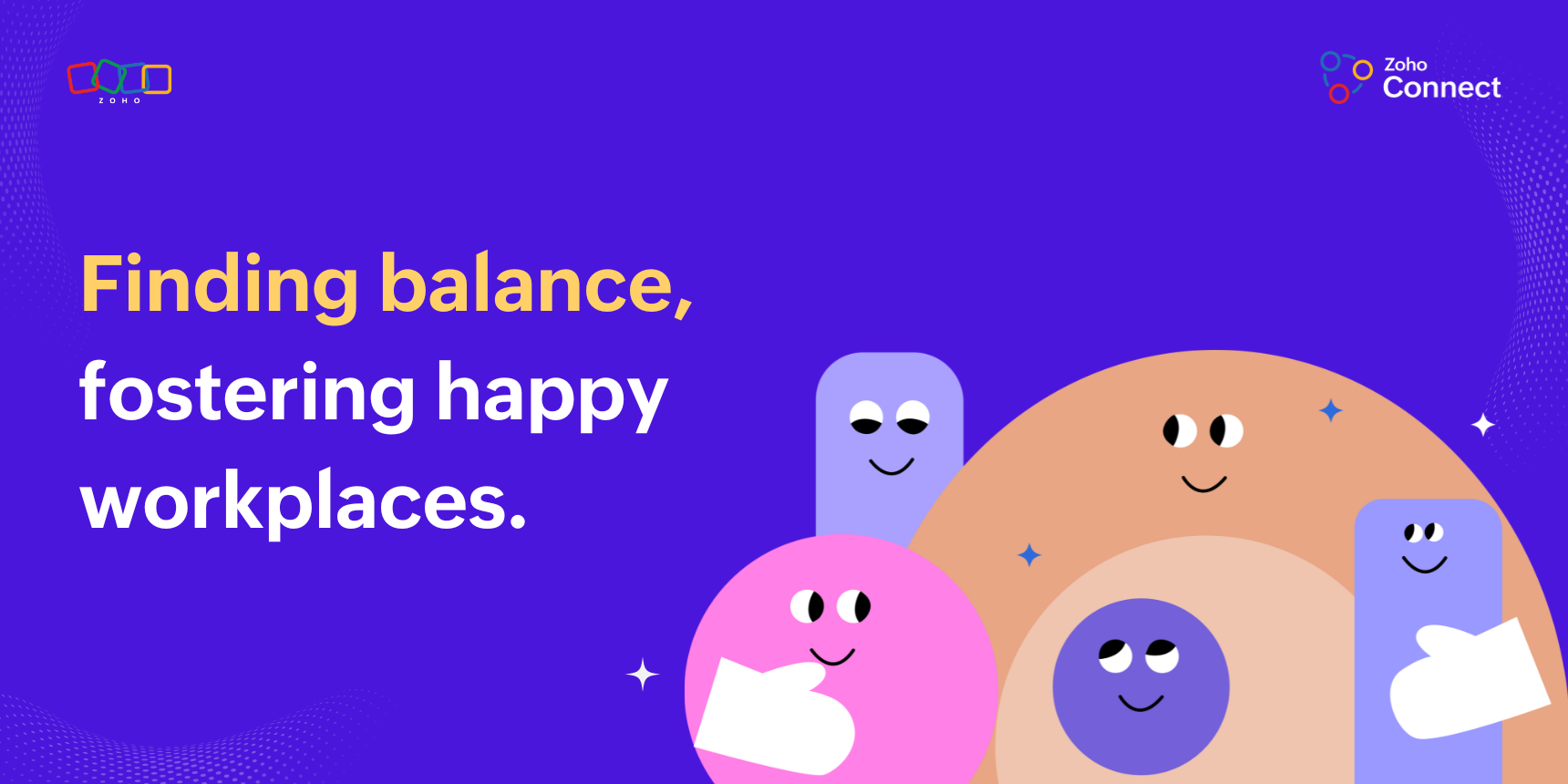- HOME
- More
- Employee Experience
- Create a supportive work environment for better employee wellness
Create a supportive work environment for better employee wellness
- Last Updated : September 13, 2024
- 594 Views
- 6 Min Read

Employee wellness has shifted from a nice-to-have to a must-have in the modern workplace. It’s no longer about just offering gym discounts—companies are now putting well-being at the heart of their culture. Why? Because happy, healthy employees aren’t only more productive but also more likely to stick around.
Headspace’s Workforce State of Mind report shows that since 2020, there’s been a big focus on mental health and how crucial it is for companies to support their employees. Let’s explore why and how employee wellness should be at the top of your list.
Why wellness is a win-win
Investing in employee wellness goes beyond just a smart business move; it’s a genuine commitment to caring for your people. When you focus on their health and happiness, you create a workplace that’s not only productive but also supportive and kind.
Here’s why prioritizing employee wellness matters
When employees feel valued and cared for, they’re more engaged and motivated. This boosts their contributions and enriches the company culture.
Well-rested, nourished, and stress-free employees are better at thinking critically, solving problems, and coming up with fresh ideas.
When employees feel connected and backed by their colleagues, they work together better and form strong bonds.
Showing that you care about employee wellness builds loyalty. This can lead to lower turnover, a more stable team, and long-term success for the company.
By investing in the well-being of your employees, you’re also investing in the future success of your organization.
1. The ripple effect of work stress on personal lives
For most people, work stress doesn’t clock out when they do. According to the Workforce State of Mind report, nearly half of employees (47%) and two-thirds of CEOs (66%) admit that the bulk of their stress comes from work. This stress doesn’t just fade away once they leave the office; it sneaks home with them, affecting their health, happiness, and even their relationships.
The numbers are alarming: According to the same report, 77% of employees say work stress has hurt their physical health, and 75% blame it for weight gain. Whether it’s looming deadlines or challenging clients, work stress can lead to sleepless nights, strained relationships, and serious health issues.
But it’s not all doom and gloom. There’s a silver lining: Companies can help lighten this load by encouraging employees to set clear boundaries between work and personal time.
What can be done to help employees manage stress?
Promote clear boundaries by encouraging employees to clock out at a set time and avoid work messages outside business hours. Leaders should model this behavior by ending meetings on time and using scheduling tools effectively.
Designate no-meeting days and offer mental health days to help employees focus and recharge. Ensure there’s time in the work schedule for personal well-being and self-care.
Clearly communicate when employees need to be available and when they have flexibility. Foster an environment where employees can adjust their schedules as needed.
Offer tailored mental health benefits that support employees and their families. Ensure benefits are comprehensive and accessible, leading to better usage and positive outcomes.
2. The power of workplace friendships
Building friendships at work isn’t just about sharing laughs or lunch breaks—it’s a big deal for employees’ mental health. Research shows that 53% of employees say their job has helped them connect with people who get them. And with loneliness being a global health issue, creating a community at work is more important than ever.
How work can brighten employees’ lives
Work can do more than just pay the bills. Here’s how:
Many employees feel work has helped them meet people with similar backgrounds or experiences.
44% of employees say their job has helped them feel less lonely.
Many employees feel that work provides them with financial stability and reduces stress.
Most employees find purpose and satisfaction through their work.
How to strengthen workplace connections
Create spaces where employees with similar backgrounds can connect and support one another. Use employee resource groups (ERGs) to host inclusive events and discussions.
Make time during the workday for employees to connect. Use EX platforms like Connect to bring your team together for shared interests or virtual meet-ups, helping them bond better.
Encourage peer-to-peer and cross-generational mentoring. Managers can help by connecting employees with mentors who can share their wisdom and experience.
3. Managers: The unsung heroes of mental health support
Managers aren’t just there to give orders—they’re the first line of support for mental health at work. Think of them as the captains of a ship, steering their team through smooth seas and stormy weather. But here’s the twist: Many managers haven’t had the training to handle this crucial role. According to UKG, almost 70% of people say their manager affects their mental health more than their therapist or doctor, and it’s just as important as their partner’s influence.
The manager’s dual role—leading and supporting
Managers play a critical role in fostering healthy workplaces. But here’s the catch: they need more support themselves. Despite the high expectations placed on them, only 24% of HR leaders report that managers are required to take mental health-specific training.
How can organizations empower managers to support their teams better?
Equip managers with skills to lead effectively and handle burnout through practical training on 1:1 meetings and mental health support.
Give managers strategies and resources to support their teams during challenging times and manage their own stress.
Make mental health resources easily available, such as coaching or virtual therapy, and encourage managers to use them.
Allow managers to implement flexible policies and create a positive work environment tailored to their team’s needs.
4. Building trust in leadership for effective mental health support
Trust isn’t built overnight, especially when it comes to mental health in the workplace. For employees to feel comfortable sharing their mental health struggles, they need to trust their leaders. One of the best ways to build this trust is through transparency. When leaders openly discuss their own mental health journeys, they set the stage for others to follow, creating a safe and supportive environment.
The shift in transparency
Recently, there’s been a significant shift in how leaders approach mental health. Back in 2020, only 35% of employees reported that their leaders talked about their own mental health. Today, that number has skyrocketed to 89%. This openness helps to destigmatize mental health issues and encourages employees to seek support when they need it.
How to sustain and grow employee trust
Global events are stressing out 98% of employees. Instead of cutting back, boost mental health support—it’ll make your employees more productive and help your business thrive.
Spread the word about mental health resources to get everyone on board. Better awareness means more people using the support available.
Boost transparency with engaging town halls or ask-me-anything sessions where leaders can address questions and provide genuine feedback, fostering active listening and trust.
5. Enhancing employee resilience amid ongoing instability
Life is full of ups and downs, and work is no exception. But with the right tools and support, employees can bounce back from challenges and keep moving forward.
Resilience isn’t just about getting through tough times; it’s about coming out stronger and better.
What the numbers say
Nine in 10 CEOs are worried about employees having the mental strength to handle changes.
Less than a quarter of employees feel they can simply move on after a major issue at work. This can lead to disruptions in their teams or even employees leaving their jobs.
But here’s the positive side: Despite the increase in mental health leave of absence, 97% of employees who use company-provided mental health benefits feel better afterward. This shows a great opportunity for employers to step up and provide the support employees need.
How to boost employee mental strength
Equip your team with the tools they need to face tough situations with confidence, empowering everyone to excel and tackle challenges head-on.
Make coming back from mental health leave easy and stress-free. Set up clear plans so employees can ease back in smoothly and feel supported.
Boost morale with ERGs for tailored support and cheer. These groups offer a friendly space for employees to find encouragement and grow stronger together.
The bottom line
Creating a workplace where everyone feels valued, supported, and connected is within reach. With Connect, you can cultivate an environment where employees can truly be themselves, share their experiences, and find a sense of belonging.
Connect empowers you to:
Establish spaces for employees to connect, express their thoughts, and bond over shared interests.
Provide essential resources and support for those facing mental health challenges.
Support employees in managing stress and maintaining healthy boundaries.
Nurture a culture where employees feel safe, supported, and respected.
Elevate your employee experience by creating a supportive, connected, and thriving workplace. Sign up for EX platforms like Zoho Connect today and start building a culture that prioritizes well-being and fosters meaningful connections.


